TS 24.090
Unstructured Supplementary Service Data (USSD)
V18.0.0 (PDF)
2024/03 15 p.
V17.0.0
2022/03 15 p.
V16.0.0
2020/06 15 p.
V15.0.0
2018/06 15 p.
V14.0.0
2017/03 15 p.
V13.0.0
2015/12 15 p.
V12.0.0
2014/09 15 p.
V11.0.0
2012/09 15 p.
V10.0.0
2011/04 15 p.
V9.0.0
2009/12 15 p.
V8.0.0
2008/12 15 p.
V7.0.0
2007/07 15 p.
V6.0.0
2005/01 15 p.
V5.0.0
2002/06 15 p.
V4.0.1
2002/06 15 p.
V3.0.0
1999/04 15 p.
GSM Rel-98 v7.0.1
2000/01 14 p.
GSM Rel-97 v6.0.1
1998/11 14 p.
GSM Rel-96 v5.0.1
1996/11 16 p.
GSM Phase-2 v4.1.1
1994/11 16 p.
- Rapporteur:
- Mr. De Gregorio, Jesus
Ericsson LM
Content for TS 24.090 Word version: 18.0.0
1 Scope p. 5
The present document gives the stage 3 description of the Unstructured Supplementary Service Data (USSD) operations.
The group of unstructured supplementary service data operations is divided into two different classes:
2 References p. 5
The following documents contain provisions which, through reference in this text, constitute provisions of the present document.
- References are either specific (identified by date of publication, edition number, version number, etc.) or non-specific.
- For a specific reference, subsequent revisions do not apply.
- For a non-specific reference, the latest version applies. In the case of a reference to a 3GPP document (including a GSM document), a non-specific reference implicitly refers to the latest version of that document in the same Release as the present document.
3 Abbreviations p. 5
Abbreviations used in the present document are listed in TR 21.905.
4 Cross phase compatibility p. 5
For the mobile initiated USSD operations, a number of changes exist between the present document and the protocol version 1 specification. For these operations the main body of the present document assumes that all network entities comply with this version of the service. In this case an additional subclause defines the additional requirements for when one or more network entities or the Mobile Station (MS) complies with the protocol version 1 specifications for the USSD operations.
5 Network initiated unstructured supplementary service data operations p. 6
5.1 Unstructured supplementary service data request p. 6
5.1.1 Normal operation p. 6
The network invokes an USSD request by sending a REGISTER message containing a UnstructuredSS-Request invoke component to the MS.
The MS shall respond to the request by sending a FACILITY message containing the user's mobile subscriber's response in a return result component. The network shall pass the data received in the response to the application handling USSD operations and shall wait for the response of the application. The application may either continue or terminate the dialogue.
When the application continues the dialogue, it may initiate another USSD operation by sending a FACILITY message (see Figure 5.2). The operation may either be an USSD request or notification (see subclause 5.1.2).
When the application terminates the dialogue, the network shall clear the transaction by sending a RELEASE COMPLETE message. The MS may also clear the transaction at any time by sending a RELEASE COMPLETE message upon the request of the user.
If the MS is unable to process the request received from the network, it shall return an error indication by sending a FACILITY message containing a return error component. Error values are specified in TS 24.080.
When the MS receives an USSD operation in parallel to any call independent supplementary service transaction, it shall respond with a return error component in a RELEASE COMPLETE message, containing the "USSD-Busy" error as specified in TS 24.080, to indicate the failure in handling a parallel USSD operation. However, the network is allowed to initiate USSD operations in parallel to call related transactions.
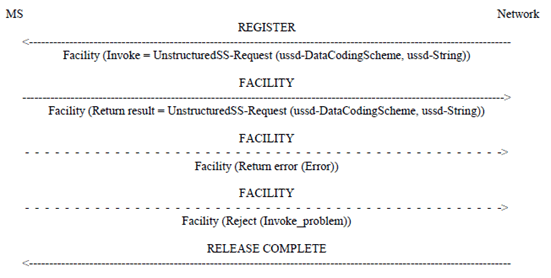
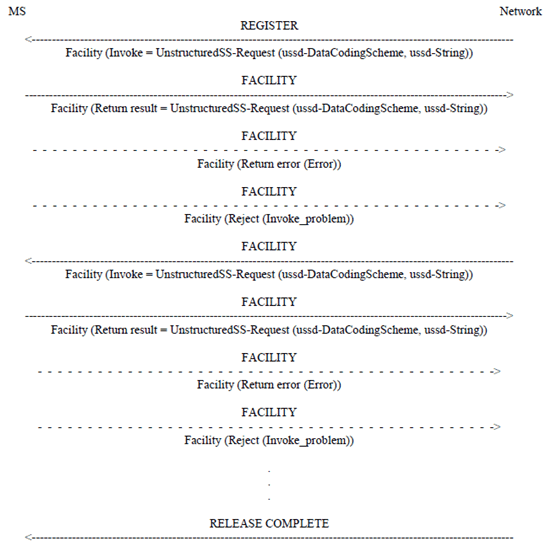
5.2 Unstructured supplementary service data notification p. 8
5.2.1 Normal operation p. 8
The network invokes an USSD notification by sending a REGISTER message to the MS containing a UnstructuredSS Notify invoke component.
The MS shall acknowledge the operation by sending a FACILITY message containing an empty result component to the network. The application may either continue or terminate the dialogue.
When the application continues the dialogue, it may initiate another USSD operation by sending a FACILITY message (see Figure 5.4). The operation may either be an USSD request (see subclause 5.1.1) or notification.
When the application terminates the dialogue, the network shall clear the transaction by sending a RELEASE COMPLETE message. The MS may also clear the transaction at any time by sending a RELEASE COMPLETE message upon request of the user.
If the MS is unable to process the request received from the network, it shall return an error indication by sending a FACILITY message containing a return error component. Error values are specified in TS 24.080.
When the MS receives an USSD operation in parallel to any call independent supplementary service transaction, it shall respond with a return error component in a RELEASE COMPLETE message, containing the "USSD-Busy" error as specified in TS 24.080, to indicate the failure in handling a parallel USSD operation. However, the network is allowed to initiated USSD operations in parallel to call related transactions.
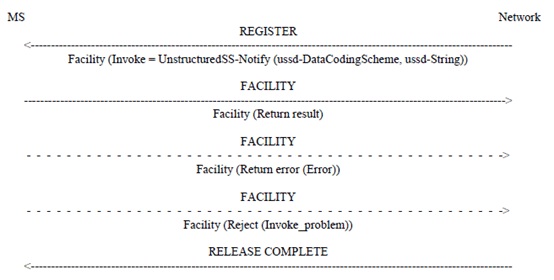
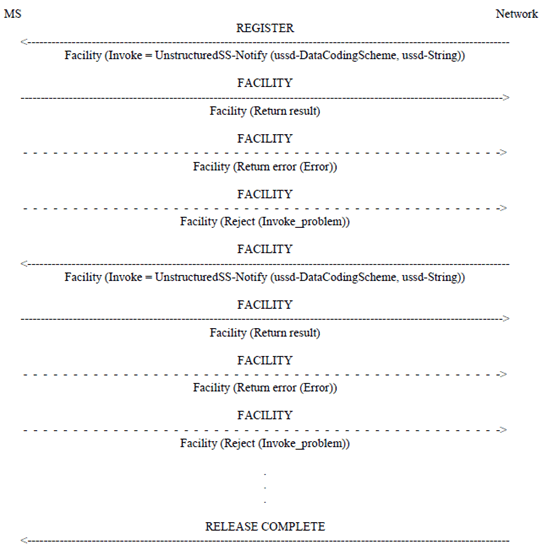
6 Mobile initiated unstructured supplementary service data operations p. 10
6.1 Normal operation p. 10
The MS invokes an USSD request by sending a REGISTER message to the network containing a ProcessUnstructuredSS-Request invoke component.
The receiving network entity shall pass the data received in the request to the application handling USSD operations and shall wait for the response of the application. The application may either terminate the dialogue or may request several times further information in order to perform the requested operation (see Figure 6.1 and Figure 6.2).
When the application requests more information to process the request, the network shall initiate an USSD request (see subclause 5.1.1), using the on-going transaction (see Figure 6.2). The MS shall return the user's response in a FACILITY message containing a return result component. The network shall pass the data received in the response to the application. If the MS is unable to process the request received from the network, it shall return an error indication by sending a FACILITY message containing a return error component.
When the application terminates the dialogue, the network shall clear the transaction by sending a RELEASE COMPLETE message containing a return result component. The MS may also clear the transaction at any time by sending a RELEASE COMPLETE message upon request of the user.
If the network is unable to process the request received from the MS, it shall clear the transaction by sending a RELEASE COMPLETE message containing a return error component. Error values are specified in TS 24.080.
The MS shall not initiate USSD operations in parallel to any call independent supplementary service transaction. Only one transaction for USSD operations per user is allowed at a time. However, the MS is allowed to initiate USSD operations in parallel to call related transactions.
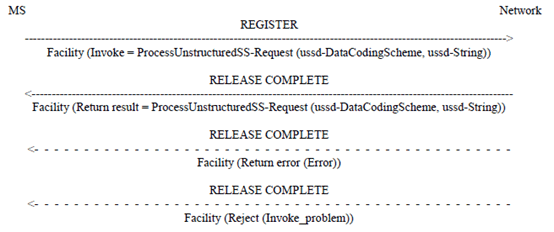
Figure 6.1: Mobile initiated USSD operation, network does not request further information
(⇒ copy of original 3GPP image)
(⇒ copy of original 3GPP image)
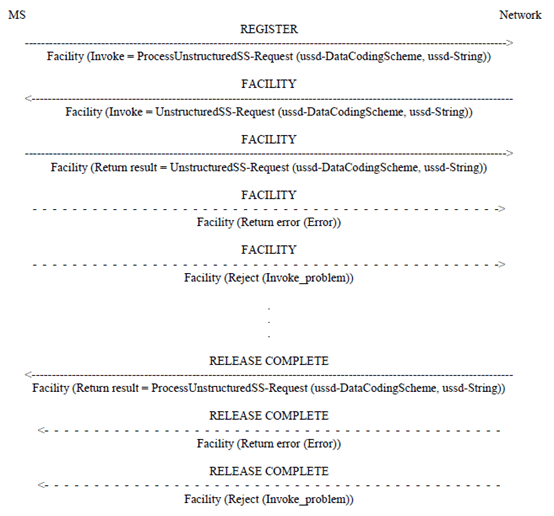
Figure 6.2: Mobile initiated USSD operation, network requests further information
(⇒ copy of original 3GPP image)
(⇒ copy of original 3GPP image)
6.2 Cross phase compatibility p. 12
6.2.1 Network only supports protocol version 1 of unstructured supplementary service data operations p. 12
If a mobile initiated USSD request using protocol version 2 is rejected by the network, and the reason for the rejection is indicated either by the problem code "unrecognized operation" or a cause "Facility rejected", the MS shall assume that the network only supports protocol version 1 of USSD operations. The MS shall re-attempt the request by using the appropriate protocol version 1 USSD operation without a SS version indicator if the unstructured data entered by the user can be coded as an IA5 string.
6.2.2 Mobile station only supports protocol version 1 of unstructured supplementary service data operations p. 12
A MS supporting only protocol version 1 invokes an USSD request by sending a REGISTER message to the network containing a ProcessUnstructuredSsData invoke component without a SS version indicator. In this situation the network is not allowed to start a network initiated USSD operation. If the application requires such an operation for its proper function, the USSD operation sent by the MS shall be rejected by the application. The network shall terminate the transaction by sending a RELEASE COMPLETE message with cause "Facility rejected" (see TS 24.008).